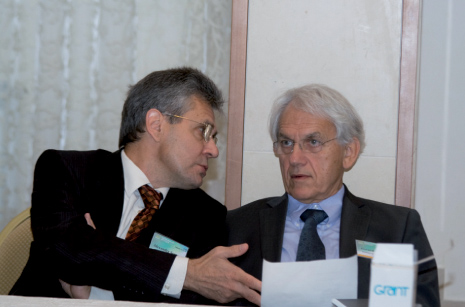Проект XCELS класса мегасайенс
Exawatt Center for Extreme Light Studies (XCELS)
Созданная в ИПФ РАН технология параметрического усиления петаваттных лазерных импульсов (OPCPA) положена в основу российского проекта XCELS, предназначенного для строительства Международного центра исследования экстремальных световых полей на базе субэксаваттного лазера. Проект одобрен в 2011 году правительственной комиссией по высоким технологиям и инновациям в числе шести проектов класса мегасайенс.

Источником экстремального светового излучения в XCELS должен стать 12-канальный лазерный комплекс с суммарной пиковой мощностью до 200 ПВт. Каждый из каналов строится по единой схеме многокаскадного параметрического усиления, прототипом которого является установка PEARL. Оптические импульсы в каналах будут сфазированы с точностью много меньше периода световой волны, что обеспечит интенсивность света при фокусировке более 1025 Вт/см2.
Для достижения импульсной мощности более 15 ПВт в каждом из каналов генерируется импульс с энергией до 400 Дж, длительностью около 25 фс, частотой повторения один выстрел в несколько часов. Апертура оконечных каскадов параметрического усиления в кристаллах DKDP составляет 30 × 30 см. Каждый из каналов параметрического усиления накачивается второй гармоникой Nd:glass лазерного усилителя с апертурой 30 × 30 см. Энергия излучения основной и второй гармоники составляет 3 и 2 кДж соответственно при длительности импульса 1,5 нс.
Полная мощность излучения 200 ПВт более чем на два порядка превышает сегодняшний мировой рекорд. Это обстоятельство будет обеспечивать превосходство создаваемой установки и научно-технологическое лидерство России не только в момент ее создания, но и на многие годы вперед и позволит осуществить уникальную программу исследований по следующим направлениям:
- создание источников сверхкороткого когерентного и некогерентного излучения с рекордной яркостью в рентгеновском и гамма-диапазонах на основе излучения ультрарелятивистских частиц, движущихся в сверхсильных полях, и их использование для диагностики процессов и структур с пикометровым пространственным и субфемтосекундным временным разрешением;
- разработка многокаскадных компактных лазерных ускорителей электронов с энергиями более 100 ГэВ, использование принципов лазерно-плазменного ускорения для разработки перспективных ускорительных комплексов с энергиями частиц на уровне 1–10 ТэВ;
- создание компактных лазерных ускорителей ионов с энергией 0,1–10 ГэВ и разработка их приложений для лучевой диагностики и медицины;
- получение и исследование экстремальных состояний вещества, возникающих под действием ультрарелятивистских лазерных полей; моделирование астрофизических и ранних космологических явлений в лабораторных условиях;
- создание источников электромагнитных волн аттосекундной (10-18 с) и субаттосекундной длительности на основе генерации высоких гармоник лазерного излучения и суперконтинуума в процессе нелинейного взаимодействия мощных фемтосекундных лазерных импульсов с веществом; разработка методов применения таких источников для фундаментальной метрологии и диагностики быстропротекающих процессов в веществе;
- создание источника электромагнитного излучения с пиковой мощностью более 1 ЭВт (1018 Вт) на основе взаимодействия мультипетаваттных лазерных импульсов с плазмой в ультрарелятивистском режиме;
- исследование пространственно-временной структуры вакуума при его зондировании излучением с интенсивностью более 1025 Вт/см2; изучение явлений квантовой электродинамики в экстремально сильных лазерных полях, в том числе создание вещества и антивещества с помощью излучения;
- исследования в новой области науки – ядерной оптике – на основе использования вторичных источников гамма-излучения для возбуждения и диагностики внутриядерных процессов.